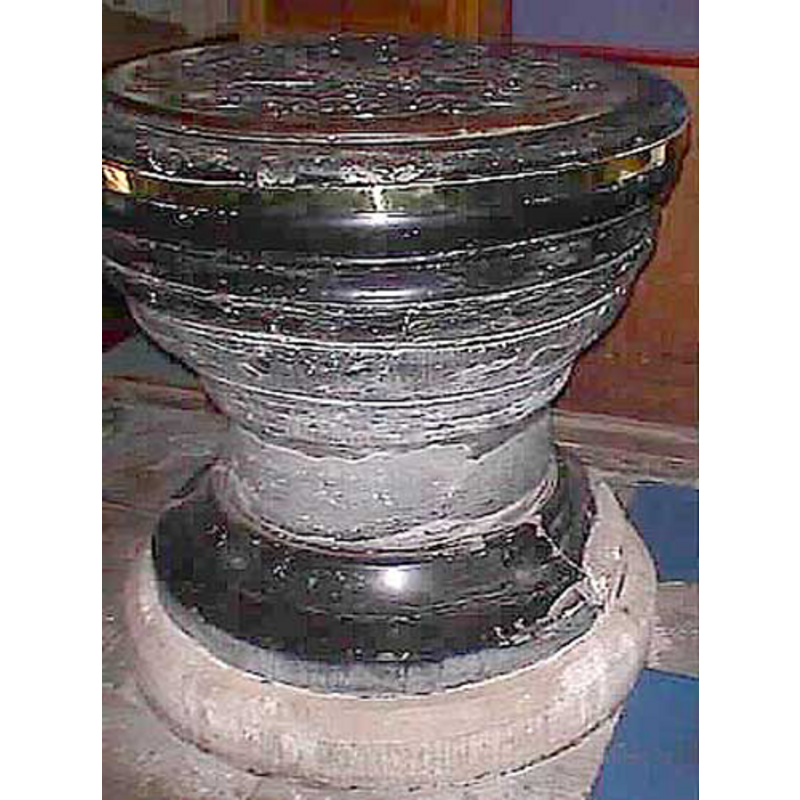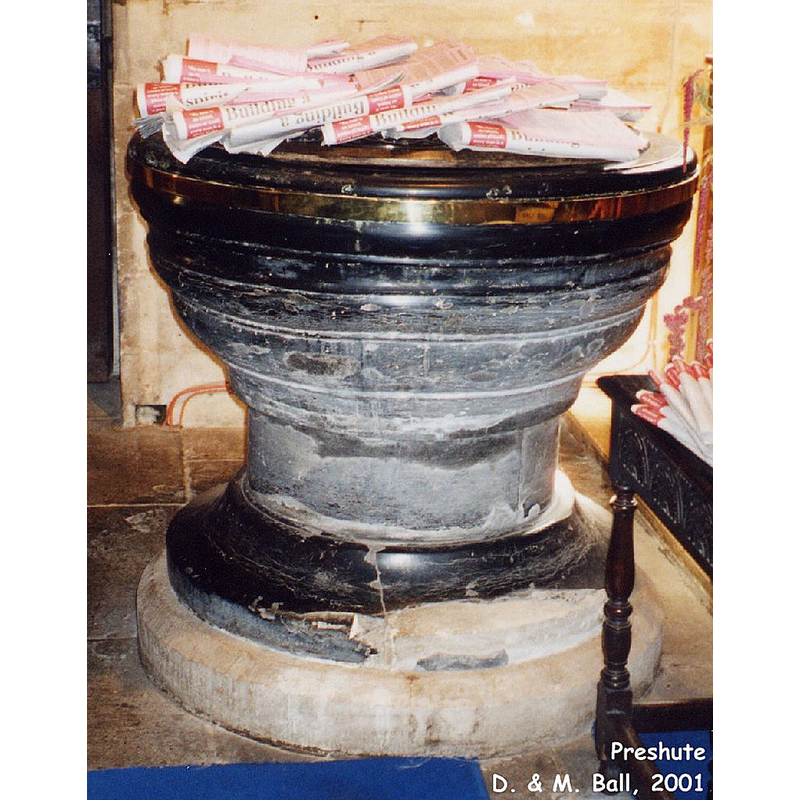Preshute No. 2

Image copyright © John Wilkes, 2006
Standing permission
Results: 5 records
B01: design element - motifs - moulding
view of church exterior
view of font
view of font and cover
view of font and cover
Scene Description: Source caption: "Truly amazing says Pevsner, & of exceptional size. Black Tournai marble font, thought to be from Henry III’s chapel at Marlborough Castle and maybe used by King John or so local legend says. Now sits inside the door of St George’s in Preshute. It’s big!"
Copyright Statement: Image copyright © Malcolm Sinclair, 2023
Image Source: in digital photograph 9 June 2023 by Malcolm Sinclair [https://x.com/HistoryMalc/status/1667069291152175105/photo/1] [accessed 21 June 2024]
Copyright Instructions: PERMISSION NOT AVAILABLE – IMAGE NOT FOR PUBLIC USE
INFORMATION
FontID: 07319PRE
Object Type: Baptismal Font1
Church/Chapel: Parish Church of St. George [orig. from the Castle Chapel of St. Nicholas?]
Church Patron Saints: St. George
Church Location: Thomson Way, Preshute, Wiltshire, SN8 1TZ
Country Name: England
Location: Wiltshire, South West
Directions to Site: Located on the A4, WSW of Marlborough
Ecclesiastic Region: Diocese of Salisbury
Historical Region: Hundred of Selkley
Font Location in Church: Reported inside the church ca. 1922
Century and Period: 12th - 13th century, Norman / Early English?
Credit and Acknowledgements: We are grateful to Duncan & Mandy Bell, of www.oodwooc.co.uk, and to John Wilkes, of www.allthecotswolds, for their photographs of this font and church.
Font Notes:
Click to view
Noted in Camden's Britannia (1607) [cf. infra]. Gough (1792) writes about the font "at Preshute near Marlborough in Wiltshire, a plain bason of dark grey marble, or as Mr. Camden [...] calls it Lapis Obsidianus [i.e., Pliny's name for obsidian], or Touchstone, two feet and a half diameter at top, ending in an inverted cone" ([NB: the reference is to Camden's 'Britannia': 1st Latin ed. in 1586; 1st English ed. in 1610]. Lewis' Dictionary of 1848 reports "a plain ancient font of dark grey marble" in this church. Noted in the Handbook for travellers… (1869): "a black basalt font of remarkable size, of the early half of the 12th cent., in which a long standing tradition mentioned by Camden tells us that King John, and other royal persannages were baptized. It is by no means improbable that the font mau have been transferred hither from the chapel of St. Nicholas in Marlborough Castle on the dismantling of that fortress." Noted in The Wiltshire Archaeological and Natural History Magazine (vol. XIX (1881): 6) as "its famous font". Listed in Cox & Harvey (1907) as a baptismal font of the Norman period. Holmes (1922) notes: "in the church at Preshute, the parish church of the Castle, is an enormous font of black marble brought from this chapel. A tradition has it that King John was baptized in it", and that it was in the Castle church that he later married Isabella of Gloucester in 1180. Buck (1951) writes of having deferred any rematks on this font for "as long as possible owing to the protracted investigation which I have been carrying out in endeavour to establish its history". That said, however, Buck (ibid.) traces the bibliographical history of this font back to Camden and Gough [cf. supra], and he also notes a 1701 manuscript (p. 40) in the Wiltshire Archaeological and Natural History Society, in which the inhabitants of Marlborough brag about the Preshute font, in which "several Princes" are said to have been baptised. Buck (ibid.) further notes the research by H. C. Brentnall, on whose evidence Buck considers "more probable and more consistent with the design of the font that it was installed during the alterations [...] carried out in the reign of Henry III" [i.e., some time in the 1230s through the 1250s], at which, Buck notes, several fonts were provided for in the Liberate Rolls, including one for the Chapel of All Saints in the manor of Clarendon, Wiltshire. Buck (ibid.) further suggests that "the font may have been removed before 1390 from the King's Chapel to Preshute Church." Buck's thorough investigation looks into the composition of the font and he notes: "an acid test gave a good reaction which showed the presence of lime; it is therefore most probably a black marble [...] The marble of the Preshute font, however, does not appear to be fossiliferous, as are Purbeck, Frosterley, Bethersden [...] and thus suggest a foreign origin, almost certainly French or Belgian. The large size of the font also favours this theory [...] Whether the Preshute font [...] came from Tournai I am unable to say yet, but the material is very similar." Buck (ibid.) closes his article assuring the reader that "Investigations, both geological and historical, regarding this font are being continued." This Buck did, in his next article on fonts (1952); a fragment of the font was sent for analysis to Belgium. The Geolical Society of Belgium returned its report with, among other information, the following [in Buck's translation]: "Therefore, the chemical composition as well as the appearance allow us to state definitely that the specimen is of Tournai stone of the type called 'Calonne black marble.'" On the Historical problem, Buck adds, "no definite evidence has yet been found either in England or Belgium to show when or why this font came to be installed at Preshute", and resolves that "it is not expedient that even an estimated date be assigned" to the font. In a final note Buck (ibid.) Adds: "this font is unique in its design, and in size and weight is bigger than any other circular font in an ordinary country parish church in England. For these reasons it might be considered that its origonal use [...] served quite a different purpose" [NB: Buck's last remark is odd. The fonts at Kilpeck and Bredwardine, in Hereford & Worcester, are comparable -Bredwardine is actually larger- in size, yet there has been no question as to their baptismal function]. The Victoria County History (Wiltshire, vol. 12, 1983) notes: "Part of a square 12th-century font is built into the porch. Its successor is a large elaborately turned and polished 13th-century font of black Tournai marble, which was in the church c. 1600 and may have been brought from St. Nicholas's chapel in Marlborough Castle after 1417". Orchard (2004) reproduces in Southern Life (UK) [www.southernlife.org.uk/wiltshire/churches/st_george_preshute.htm] the contents of a guide by Lane & Kempson (1962) with the following section on the font: "The Font.-- For a small country church like Preshute the size, 3ft 5 1/2 ins outside diameter, is immense. It is made from a black marble (called 'touchstone' in Camden) [cf. supra] which is used for only seven other fonts in the country. Most of these, including the examples in Winchester Cathedral, the Minster at Lincoln, and East Meon church in Hampshire, are square and highly decorated. This one is round and simple, turned on a lathe and with wide and shallow mouldings. It has recently been established that the stone came from a quarry at Callonne, just outside Tournai in Belgium. The district was once famous for its building stone, but later experience proved it unsuitable for exposure to the weather. It is now only used for making cement. In a 'terrier' or inventory the font is described as having 'an high oaken covering'. At the restoration and rebuilding in 1854 this was replaced by the present flat oak lid, and the font ingeniously repaired round the top with brass to prevent further fractures. The most likely explanation of its presence here is that it was brought from the old chapel of St. Nicholas in Marlborough Castle. The castle was not in Marlborough parish, but just inside that of old Preshute; and the chapel, which existed before 1225, was served by a priest until at least 1420, by which time both it and the Castle had fallen into complete disrepair. The font however would remain fit for use, and must at some time have been transferred to the mother church at Preshute. By tradition some of King John's family are said to have been baptised in it; other baptisms of interest are recorded later". [NB: the latter identification of the stone of the font is obviously the most likely, since making a font out of the hard volcanic obsidian would be a daunting job, beside the fact that obsidian would not wear from exposure to the elements as Tournai limestone does -- it is unlikely however that the font was turned in a lathe, as stated in the guide above].. Noted in Pevsner & Cherry (1975): "Font. A truly amazing piece of black Tournai marble. The date must be C13. Powerful mouldings and nothing else at all except a quite exceptional size. The font is suppose to come from Marlbotough Castle. St. George was the parish church of the castle are."
COORDINATES
UTM: 30U 585571 5698697
MEDIUM AND MEASUREMENTS
Material: stone, limestone (black and blue) (Tournai marble)
Font Shape: round
Basin Interior Shape: round
Basin Exterior Shape: round
Diameter (includes rim): 103.75 cm* [approx.] -- 75 cm** [approx.]
Notes on Measurements: * [in Lane & Kempson (1962) as 3ft. 5 1/2 in.] -- ** [in Gough (1792) as 'two feet and half diameter at top] [NB: Lane & Kempson's measurement is probably the right one]
LID INFORMATION
Date: 19th century
Material: wood, oak
Apparatus: no
Notes: [earlier font cover removed -- cf. FontNotes]
REFERENCES
Victoria County History [online], University of London, 1993-. Accessed: 2008-12-24 00:00:00. URL: https://www.british-history.ac.uk.
Buck, A.G. Randle, "Some Wiltshire fonts. Part III", LIV, CXCV (December 1951), The Wiltshire Archaeological and Natural History Magazine, 1951, pp. 192-209; p. 205-209 and pl. XII.63
Buck, A.G. Randle, "Some Wiltshire fonts. Part IV", LIV, CXCVII (December 1952), The Wiltshire Archaeological and Natural History Magazine, 1952, pp. 429-434; p. 429-434
Camden, William, Britannia [... with a translation by Philemon Holland], 1607
Cox, John Charles, English Church Furniture, New York: E.P. Dutton & Co., 1907
Cox, John Charles, Nottinghamshire, London: Allen, 1912
Gough, Richard, "Description of the old font in the Church of East Meon, Hampshire, 1789: with some observations on fonts", X, Archaeologia, 1792, pp. 183-209; p. 186
Holmes, Edric, Wanderings in Wessex: an Exploration of the Southern Realm from Itchen to Otter, London: Robert Scott Roxburghe House, [1922]
Lane, R.H., The Parish and Church of St. George at Preshute: a short history and guide, [s.l.]: [published for the Parish of Preshute], 1962
Lewis, Samuel, A Topographical Dictionary of England, Comprising the Several Counties, Cities, Boroughs, Corporate and Market Towns, Parishes, Chapelries, and Townships, and the Islands of Guernsy, Jersey, and Man, with Historical and Statistical Descriptions [...], London: S. Lewis, 1831
Murray, John, A handbook for travellers in Wiltshire, Dorsetshire, and Somersetshire, London: John Murray, 1869


